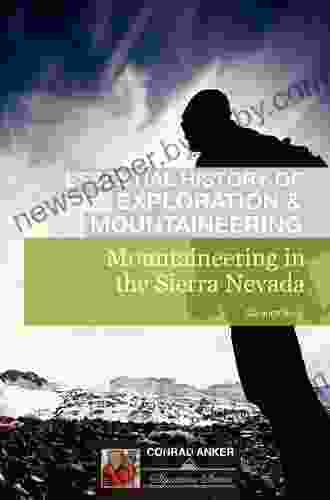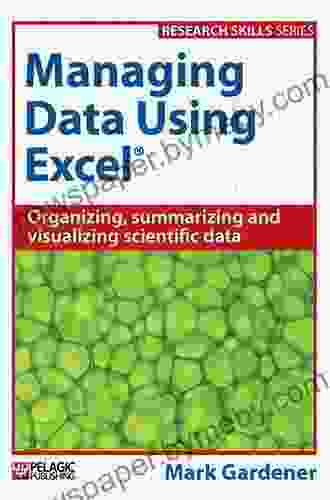Unleash the Power of Scientific Data: A Comprehensive Guide to Organizing, Summarizing, and Visualizing Research Findings

In the realm of scientific research, data plays a pivotal role. However, the sheer volume and complexity of data can often pose significant challenges to researchers. Effectively organizing, summarizing, and visualizing scientific data are crucial skills that empower researchers to extract meaningful insights, communicate their findings, and make informed decisions.
This comprehensive guide will delve into the essential principles and best practices of scientific data management, providing researchers with the tools and techniques they need to harness the full potential of their data.
4.1 out of 5
| Language | : | English |
| File size | : | 37142 KB |
| Text-to-Speech | : | Enabled |
| Screen Reader | : | Supported |
| Enhanced typesetting | : | Enabled |
| Word Wise | : | Enabled |
| Print length | : | 619 pages |
Chapter 1: Organizing Scientific Data
The foundation of effective data management lies in efficient organization. Researchers must establish a systematic approach to data storage and retrieval to minimize errors and maximize productivity.
1.1 Data File Management
Organize data files into a logical structure, using descriptive file names and a consistent naming convention. Utilize subfolders to categorize files based on experiment, data type, or other relevant criteria.
1.2 Metadata Management
Metadata provides essential information about data files, such as experimental conditions, instruments used, and data processing history. Create standardized metadata templates and ensure that all data files are properly documented.
1.3 Data Backup and Recovery
Protect valuable data from loss by implementing a robust backup strategy. Store backups on multiple devices and in different physical locations to minimize the risk of data corruption or accidental deletion.
Chapter 2: Summarizing Scientific Data
Summarizing data involves extracting meaningful information and presenting it in a concise and informative manner. Researchers can utilize various statistical and graphical methods to summarize data effectively.
2.1 Descriptive Statistics
Descriptive statistics provide an overview of data distribution. Measures such as mean, median, standard deviation, and range help researchers understand central tendencies, variability, and outliers.
2.2 Inferential Statistics
Inferential statistics allow researchers to draw s about a larger population based on a sample. Hypothesis testing and confidence intervals are powerful tools for evaluating the significance of research findings.
2.3 Data Visualization
Visualizing data through graphs, charts, and diagrams makes it easier to identify patterns, trends, and relationships. Different types of visualizations are suitable for different types of data and research questions.
Chapter 3: Visualizing Scientific Data
Effectively communicating research findings requires the ability to visualize data in a clear and engaging manner. Researchers must consider various factors to create impactful visualizations.
3.1 Choosing the Right Visualization
The type of visualization depends on the nature of the data, the research question, and the intended audience. Bar charts, line graphs, scatter plots, and heat maps are commonly used visualization techniques.
3.2 Design Principles
Follow design principles such as color theory, typography, and layout to create aesthetically pleasing and informative visualizations. Ensure that visualizations are clear, concise, and avoid visual clutter.
3.3 Interactive Visualizations
Interactive visualizations allow users to explore data in real-time, making them ideal for complex datasets or data exploration. Utilize interactive features such as zoom, pan, and filtering to provide a more engaging experience.
Chapter 4: Case Studies and Applications
To illustrate the practical applications of organizing, summarizing, and visualizing scientific data, this chapter presents real-world case studies from various scientific disciplines.
4.1 Medical Research
Effectively managing and visualizing patient data is essential for clinical research. Case studies demonstrate how data organization and visualization can improve patient outcomes and advance medical knowledge.
4.2 Environmental Science
Environmental scientists rely heavily on data to monitor environmental changes. Case studies showcase how visualizing data can help identify pollution sources, track wildlife populations, and predict natural disasters.
4.3 Social Sciences
Social scientists analyze data to understand human behavior and society. Case studies demonstrate how data summarization and visualization can uncover trends, identify social inequalities, and inform policy decisions.
Mastering the skills of organizing, summarizing, and visualizing scientific data is essential for researchers to maximize the impact of their research. By effectively managing and presenting data, researchers can extract meaningful insights, communicate their findings with clarity, and contribute to the advancement of knowledge in their respective fields.
This comprehensive guide provides a solid foundation for researchers to develop these critical skills and become proficient in scientific data management. By embracing the principles and techniques outlined in this guide, researchers can unlock the full potential of their data and make significant contributions to the scientific community.
4.1 out of 5
| Language | : | English |
| File size | : | 37142 KB |
| Text-to-Speech | : | Enabled |
| Screen Reader | : | Supported |
| Enhanced typesetting | : | Enabled |
| Word Wise | : | Enabled |
| Print length | : | 619 pages |
Do you want to contribute by writing guest posts on this blog?
Please contact us and send us a resume of previous articles that you have written.
 Book
Book Novel
Novel Page
Page Chapter
Chapter Text
Text Story
Story Genre
Genre Reader
Reader Library
Library Paperback
Paperback E-book
E-book Magazine
Magazine Newspaper
Newspaper Paragraph
Paragraph Sentence
Sentence Bookmark
Bookmark Shelf
Shelf Glossary
Glossary Bibliography
Bibliography Foreword
Foreword Preface
Preface Synopsis
Synopsis Annotation
Annotation Footnote
Footnote Manuscript
Manuscript Scroll
Scroll Codex
Codex Tome
Tome Bestseller
Bestseller Classics
Classics Library card
Library card Narrative
Narrative Biography
Biography Autobiography
Autobiography Memoir
Memoir Reference
Reference Encyclopedia
Encyclopedia Suzanne Schlosberg
Suzanne Schlosberg M Terese Verklan
M Terese Verklan Paul Doty
Paul Doty Phil Dean
Phil Dean John K Stutterheim
John K Stutterheim Jim Forest
Jim Forest Ori Brafman
Ori Brafman Tim Mcgrath
Tim Mcgrath Ryder Carroll
Ryder Carroll Lara Bazelon
Lara Bazelon Kathryn Harrison
Kathryn Harrison John Groarke
John Groarke Sofia Price
Sofia Price Ray Ordorica
Ray Ordorica John Bloom
John Bloom Shaun Tomson
Shaun Tomson Joey Acker
Joey Acker Ona Carbonell
Ona Carbonell Suzanne I Barchers
Suzanne I Barchers Judy Donnelly
Judy Donnelly
Light bulbAdvertise smarter! Our strategic ad space ensures maximum exposure. Reserve your spot today!

 Owen SimmonsFinding My Purpose As An Immigrant: A Journey of Discovery and Transformation
Owen SimmonsFinding My Purpose As An Immigrant: A Journey of Discovery and Transformation
 Greg FosterUnleash the Wolves: Embark on a Captivating Biblical Adventure with "Wolves:...
Greg FosterUnleash the Wolves: Embark on a Captivating Biblical Adventure with "Wolves:... Gordon CoxFollow ·9.4k
Gordon CoxFollow ·9.4k Neil GaimanFollow ·15k
Neil GaimanFollow ·15k Howard PowellFollow ·16k
Howard PowellFollow ·16k Paul ReedFollow ·13k
Paul ReedFollow ·13k Gerald ParkerFollow ·9.9k
Gerald ParkerFollow ·9.9k Chadwick PowellFollow ·18.3k
Chadwick PowellFollow ·18.3k Curtis StewartFollow ·11.8k
Curtis StewartFollow ·11.8k Emmett MitchellFollow ·10.2k
Emmett MitchellFollow ·10.2k

 Jermaine Powell
Jermaine PowellThe Ultimate Guide to Unlocking Consistent Profitable...
Introducing the 2nd Edition of the...

 Yasunari Kawabata
Yasunari KawabataMinute Microskills Videos: The Ultimate Guide for Visual...
Unlock Your Potential with Bite-Sized Video...

 Nathan Reed
Nathan ReedUnveiling the Wonders of Yosemite through John Muir's...
Immerse yourself in the breathtaking beauty...

 Gabriel Garcia Marquez
Gabriel Garcia MarquezWhen You Find Me Novel: A Gripping Mystery Unravels
In the sleepy...

 Esteban Cox
Esteban CoxMountains of California: An Essential History of...
From the towering...

 Devin Ross
Devin RossComm Check: Unveiling the Heartbreaking Final Flight of...
Comm Check: The Final Flight of Shuttle...
4.1 out of 5
| Language | : | English |
| File size | : | 37142 KB |
| Text-to-Speech | : | Enabled |
| Screen Reader | : | Supported |
| Enhanced typesetting | : | Enabled |
| Word Wise | : | Enabled |
| Print length | : | 619 pages |








